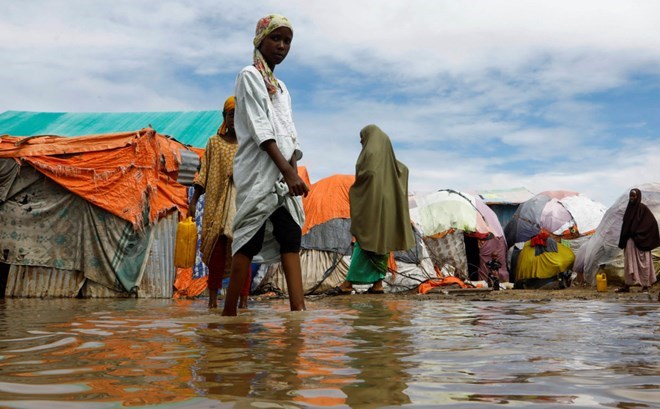Mogadishu (KAAB TV) – Torrential rains and widespread flooding have hit parts of Somalia since mid-April, affecting more than 45,000 people and claiming at least four lives, according to a report released by the United Nations Office for the Coordination of Humanitarian Affairs (OCHA) on April 30.
The report confirmed the deaths of two children and a woman in the Isku-Shuban district of Bari region, while another 12-year-old girl was killed in Baidoa. The hardest-hit areas include Puntland, particularly the Bari and Nugaal regions.
In Hirshabelle State, the Shabelle River burst its banks on April 28 in the Jowhar district, causing severe flooding that displaced approximately 6,120 people from five villages. The floodwaters inundated around 11,000 hectares of fertile farmland across the villages of Gafay, Muryaale, Beyhaaw, IJI, and Nuurkay, destroying homes and crops in one of Somalia’s most productive agricultural zones. Many families have sought refuge in makeshift shelters in the highlands, now facing critical shortages of food, clean water, and medical care.
In Galmudug State, heavy rains on April 29 led to flash flooding in Galkayo, affecting over 9,570 internally displaced persons (IDPs) across 14 camps in both the northern and southern parts of the city. Although the rains have brought some relief after six months of prolonged drought—replenishing water sources and grazing lands—they have also heightened the vulnerability of displaced communities.
Meanwhile, the Somalia Land and Water Information Management (SWALIM) project, managed by the UN’s Food and Agriculture Organization (FAO), has forecast light to moderate rains in southern and central Somalia. Dry conditions are expected to persist in Somaliland and Puntland. River levels in the Shabelle are expected to rise moderately but remain below natural floodplains. However, there is ongoing concern about localized flooding in low-lying areas near Jowhar due to man-made obstructions. The Jubba River is expected to fluctuate but remains below flood risk levels.
Despite the growing humanitarian needs, the 2025 Humanitarian Needs and Response Plan for Somalia was only 10 percent funded as of April 30. OCHA is urging international partners to urgently scale up emergency aid, particularly in the areas of shelter, sanitation, and resettlement, for communities already devastated by displacement and infrastructure damage.


